


| |
 |
Clarke is in issue #3 of |
 Clarke
was born in Dublin in 1889. His father was a craftsman who produced,
among other objects d'art, stained glass windows. Most of us know
Clarke's work from his drawings which are all too often and all
too unfairly compared to Beardsley, but it was as a stained glass
designer and artisan that he devoted the most of his too-short
life. He studied in his father's studio and for a short time in
London. In 1907 he was exposed to the works of Beardsley at the
Irish International Exhibition, but was likewise entranced by
the art of Rossetti, Annie French, E.J.
Sullivan and others. By 1909 he was accepting the occasional
graphic commission and working at the more creative and critical
aspects of the stained glass process. That same year he was awarded
a Scholarship in Stained Glass and commenced daily classes with
A.E. Child at the Dublin Art School.
Clarke
was born in Dublin in 1889. His father was a craftsman who produced,
among other objects d'art, stained glass windows. Most of us know
Clarke's work from his drawings which are all too often and all
too unfairly compared to Beardsley, but it was as a stained glass
designer and artisan that he devoted the most of his too-short
life. He studied in his father's studio and for a short time in
London. In 1907 he was exposed to the works of Beardsley at the
Irish International Exhibition, but was likewise entranced by
the art of Rossetti, Annie French, E.J.
Sullivan and others. By 1909 he was accepting the occasional
graphic commission and working at the more creative and critical
aspects of the stained glass process. That same year he was awarded
a Scholarship in Stained Glass and commenced daily classes with
A.E. Child at the Dublin Art School.
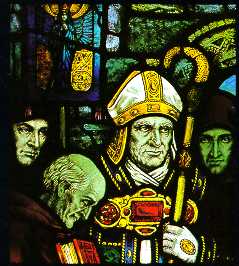 His
first entry to the Board of Education National Competition won
the Gold Medal in the stained glass competition in 1910. It was
The Consecration of St. Mel, Bishop of Longford, by St. Patrick,
as seen at left, and demonstrates the maturity he displayed early
on in his chosen field of endeavor. His education continued via
scholarship and he won the Gold Medal for stained glass in the
National Competition three times. After his three year course,
he traveled to London where he began his illustrative career with
two major efforts that never saw print: The Rape of the Lock
and Rime of the Ancient Mariner. The former was a private
commission that raises a lot of questions. Beardsley had illustrated
the poem not 20 years prior and comparisons would have been inevitable
due to the stylistic similarities. It strikes me as perhaps a
youthful challenge that Clarke dared not refuse. It may never
have been intended for publication and the extant images are not
that impressive. The Rime of the Ancient Mariner was much
more mature and displayed the density of texture and design that
would be his trademark.
His
first entry to the Board of Education National Competition won
the Gold Medal in the stained glass competition in 1910. It was
The Consecration of St. Mel, Bishop of Longford, by St. Patrick,
as seen at left, and demonstrates the maturity he displayed early
on in his chosen field of endeavor. His education continued via
scholarship and he won the Gold Medal for stained glass in the
National Competition three times. After his three year course,
he traveled to London where he began his illustrative career with
two major efforts that never saw print: The Rape of the Lock
and Rime of the Ancient Mariner. The former was a private
commission that raises a lot of questions. Beardsley had illustrated
the poem not 20 years prior and comparisons would have been inevitable
due to the stylistic similarities. It strikes me as perhaps a
youthful challenge that Clarke dared not refuse. It may never
have been intended for publication and the extant images are not
that impressive. The Rime of the Ancient Mariner was much
more mature and displayed the density of texture and design that
would be his trademark.
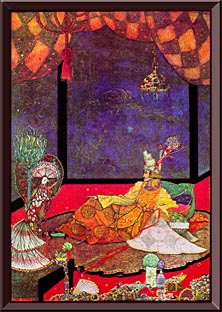
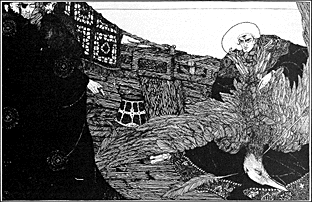 The
Rime, (at left) was intended for his first published work,
but it wasn't to be. While in London in 1913, he made the rounds
of the publishers looking for illustration work. He met with no
success at a dozen publishing houses. Then George Harrap divined
his genius and hired him, on the spot, to provide illustrations
for an edition of Andersen's Fairy Tales in both a trade
and deluxe edition - almost unheard of for an untested, unknown
and very young illustrator. The image at right is from The
Nightingale and shows Clarke's debt to both Dulac and Nielsen.
The Rime was put on hold and work began immediately on
the Andersen. This was to occupy several years and finally
see print in 1916, the same year that The Rime project
was abandoned after most of the drawings and all of the blocks
were destroyed in a devastating Dublin riot called the "The
1916 Easter Rising." By this time, however, Harry was already
planning and working on Tales of Mystery and Imagination by
E.A. Poe.
The
Rime, (at left) was intended for his first published work,
but it wasn't to be. While in London in 1913, he made the rounds
of the publishers looking for illustration work. He met with no
success at a dozen publishing houses. Then George Harrap divined
his genius and hired him, on the spot, to provide illustrations
for an edition of Andersen's Fairy Tales in both a trade
and deluxe edition - almost unheard of for an untested, unknown
and very young illustrator. The image at right is from The
Nightingale and shows Clarke's debt to both Dulac and Nielsen.
The Rime was put on hold and work began immediately on
the Andersen. This was to occupy several years and finally
see print in 1916, the same year that The Rime project
was abandoned after most of the drawings and all of the blocks
were destroyed in a devastating Dublin riot called the "The
1916 Easter Rising." By this time, however, Harry was already
planning and working on Tales of Mystery and Imagination by
E.A. Poe.
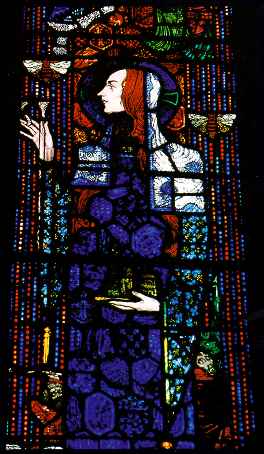 It's very important to pause here and realize
that Clarke wasn't just illustrating books. To only consider this
aspect of his creativity is greatly misleading. Illustrations
may have paid the early bills, but stained glass was his career.
He continued to submit designs to competitions and one of his
panels, The Baptism of St. Patrick was selected for an
exhibition in the Louvre in 1914. Clarke saw this exhibition while
he was traveling in Paris on scholarship, studying the stained
glass of the great cathedrals. He submitted designs for windows
in the Honan Chapel in Cork. He would eventually craft five stunning
windows, installed there in 1916-17, that would make his reputation
(see the sample at left).
It's very important to pause here and realize
that Clarke wasn't just illustrating books. To only consider this
aspect of his creativity is greatly misleading. Illustrations
may have paid the early bills, but stained glass was his career.
He continued to submit designs to competitions and one of his
panels, The Baptism of St. Patrick was selected for an
exhibition in the Louvre in 1914. Clarke saw this exhibition while
he was traveling in Paris on scholarship, studying the stained
glass of the great cathedrals. He submitted designs for windows
in the Honan Chapel in Cork. He would eventually craft five stunning
windows, installed there in 1916-17, that would make his reputation
(see the sample at left).
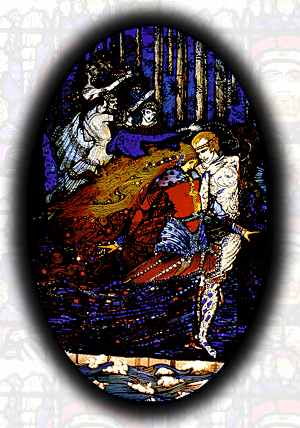 The Arts and Crafts movement triggered a resurgence
of Irish art. Clarke designed fabrics and handkerchiefs, boxes
and lanterns, but primarily he designed windows. The illustrations
for Andersen and Poe, for example, extended from
1913 to late 1919. Two books, during which time he designed and
crafted more than a dozen windows for war memorials and chapels,
as well as several panels for private commissions. These were
often interpretations of poems or ballads done in small (7"x12")
format. A Meeting appears at right.
The Arts and Crafts movement triggered a resurgence
of Irish art. Clarke designed fabrics and handkerchiefs, boxes
and lanterns, but primarily he designed windows. The illustrations
for Andersen and Poe, for example, extended from
1913 to late 1919. Two books, during which time he designed and
crafted more than a dozen windows for war memorials and chapels,
as well as several panels for private commissions. These were
often interpretations of poems or ballads done in small (7"x12")
format. A Meeting appears at right.
Another grand glass commission was The Eve of St. Agnes which illustrated Keats' poem of that name. We tend to think of stained glass windows as religious icons, but Clarke spent much of his time on secular and literary designs. These images, and many more, are reproduced in Nicola Gordon Bowe's excellent The Life and Work of Harry Clarke. (see below for more stained glass)
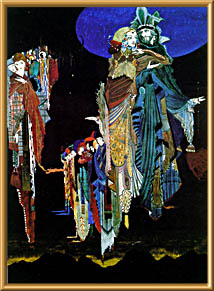 Getting
back to books (you just knew I would), I've always considered
Clarke's Tales of Mystery and Imagination to be the "World's
most common rare book." Published in October of 1919 to record
sales and critical success, it went through numerous Harrap editions
including a 1923 enlarged edition with eight color plates added.
These new color plates show strong design elements of his glass
work, as can easily be seen from the image at left, but I'm not
sure they add that much to the book. The book was published in
America by Brentanos and Tudor and went through innumerable editions
of varying print quality.
Getting
back to books (you just knew I would), I've always considered
Clarke's Tales of Mystery and Imagination to be the "World's
most common rare book." Published in October of 1919 to record
sales and critical success, it went through numerous Harrap editions
including a 1923 enlarged edition with eight color plates added.
These new color plates show strong design elements of his glass
work, as can easily be seen from the image at left, but I'm not
sure they add that much to the book. The book was published in
America by Brentanos and Tudor and went through innumerable editions
of varying print quality.
 It was the black and white work that made Tales a success.
Though his work is still often compared to Beardsley, I find the
images much more elaborate and more interesting than Beardsely.
Certainly more disturbing! Clarke brought with him the
stained glass techniques that he was so familiar with and the
majority of the Poe images rely on white lines and patterns picked
out of a black background. The resulting images are stunning,
but they do rely heavily on a quality printing job to achieve
their maximum effectiveness. The web isn't the greatest venue
for reproducing fine-line b&w artwork, but look at the reduced
version of the plate from Poe at right and then examine the detailed
enlargement below to see just how dense the texture of the image
really was.
It was the black and white work that made Tales a success.
Though his work is still often compared to Beardsley, I find the
images much more elaborate and more interesting than Beardsely.
Certainly more disturbing! Clarke brought with him the
stained glass techniques that he was so familiar with and the
majority of the Poe images rely on white lines and patterns picked
out of a black background. The resulting images are stunning,
but they do rely heavily on a quality printing job to achieve
their maximum effectiveness. The web isn't the greatest venue
for reproducing fine-line b&w artwork, but look at the reduced
version of the plate from Poe at right and then examine the detailed
enlargement below to see just how dense the texture of the image
really was.
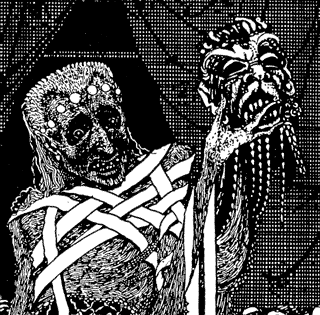
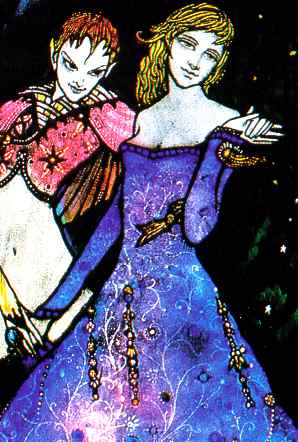
 Other illustrated
books would follow. The Year's at the Spring, Fairy
Tales of Perrault, Faust, and Selected Poems
of Algernon Charles Swinburne featured both pen and ink and
pen and wash drawings and/or more advanced color work. Faust
was laden with dark and grotesque art that "anticipates the
psychedelic, drug-induced fantasies of the 1960s." according
to Bowe. The sample at left is ample proof of that claim. There
were 64 vignettes in the text, each more disturbing than the previous.
The work met with little critical success in 1925, but Clarke
considered it his best book.
Other illustrated
books would follow. The Year's at the Spring, Fairy
Tales of Perrault, Faust, and Selected Poems
of Algernon Charles Swinburne featured both pen and ink and
pen and wash drawings and/or more advanced color work. Faust
was laden with dark and grotesque art that "anticipates the
psychedelic, drug-induced fantasies of the 1960s." according
to Bowe. The sample at left is ample proof of that claim. There
were 64 vignettes in the text, each more disturbing than the previous.
The work met with little critical success in 1925, but Clarke
considered it his best book.
Swinburne was published in 1928, giving him a total of six major books illustrated in 15 years. Compare that to the more than 130 stained glass windows that he and his studio designed and crafted and it becomes very evident where his passions lay. His techniques and talents in glass often surpassed the drawing skills of other artists. The 1929 Geneva Window (sample at right) shows just how creative and daring he could be in a medium that was technically difficult to begin with. The colors, patterns and expressions surpass much of what was being published at the time. And this is merely a small portion of one half of one of eight panels of one stained glass job.
Ill-health plagued him much of the last years of his life.
He worked at a feverish pace creating glass and book illustrations
while trying to maintain his father's decoration studio, which
he and his brother Walter ran after the untimely death of their
father in 1921. In 1930, shortly before his death, he split the
stained glass business off from the decorating business and closed
the latter. Walter died in July and Clarke worked even harder,
despite his own frailty, to inspire confidence in his newly formed
studio. He died in early 1931 while trying to recuperate from
his efforts. He was 41.
 To learn more about Harry Clarke, see:
To learn more about Harry Clarke, see:
| Harry Clarke | Nicola Gordon Bowe, 1979 Douglas Hyde |
| Harry Clarke: His Graphic Art | Nicola Gordon Bowe, 1983 Dolmen |
| The Life and Work of Harry Clarke | Nicola Gordon Bowe, 1989 Irish Academic Press |
| The Vadeboncoeur Collection of Knowledge | Jim Vadeboncoeur, Jr. |
| The Vadeboncoeur Collection of B&W ImageS 3 | Jim Vadeboncoeur, Jr. 2006, JVJ Publishing |
Or visit the Camel Productions site for information on their documentary: Harry Clarke: Darkness in Light.
|
Illustrations are copyright by their
respective owners. his page written, designed & © 1998 by Jim Vadeboncoeur, Jr. Updated 2011. |
